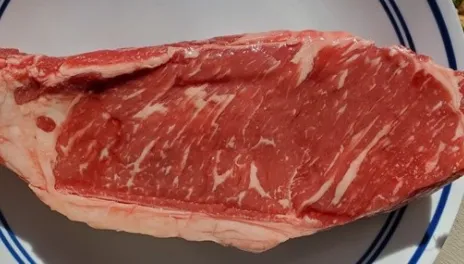Our cattle do marble!
The North Dakota Angus University feedout project was harvested in early October. These Spring-born steer calves, consigned by several ND black Angus cattle producers, were placed on feed at the Carrington Research Extension Center livestock feedlot during the first week of June 2021.
Carcasses graded 87% USDA Choice or Prime, and therefore qualified for the “Certified Angus Beef” label. “Choice” and “Prime” are quality grades established by the U.S. Department of Agriculture to describe very high-quality beef (and other meats) regarding tenderness, juiciness, and flavor. Choice is the second-highest meat quality grade, and Prime is the highest.
USDA “Choice” has three intermediate degrees – Small (low Choice), Modest (average Choice), and Moderate (high Choice). Average and high Choice are combined as ‘upper 2/3 Choice” for a “G1” specification that is known as CAB – Certified Angus Beef. This pen of cattle graded 55% Prime and G1.
White fat within the muscle is called marbling. As the more fat is deposited in the muscle, the marbling score increases and creates a juicy, tasty steak. USDA quality grades of Choice and Prime reflect the amount of marbling, with Prime containing more marbling than CAB (upper 2/3 choice). CAB has more marbling than low Choice, and low Choice has more marbling than Select grade.
In addition to the Modest or Moderate marbling grade (upper 2/3 Choice), Certified Angus Beef must also meet the following requirements:
- Phenotypic or genotypic requirements of the American Angus Association’s Live Animal Specification (black hided)
- Classed as Steer and Heifer carcasses only
- U.S. Prime and Choice, and have a minimum marbling score of Modest Choice d. Less than 30 months of age with lean color, texture, and firmness, meeting the requirements for A maturity in the U.S. grade it qualifies for
- Medium or fine marbling texture
- Ribeye Area of 10.0 to 16.0 square inches
- Hot Carcass Weight of 1,050 pounds or less;
- Fat Thickness of 1.0 inch or less
- Moderately thick or thicker muscling and tend to be at least moderately wide and thick in relation to their length
- No hump exceeding 2 inches in height
- Practically free (not detracting from visual quality) of capillary rupture in the ribeye muscle
- Free of “dark cutting” characteristicsOther USDA specification programs that can be reviewed at https://www.ams.usda.gov/sites/default/files/media/LPSCertifiedBeefProgramComparison.pdf
If you are interested learning about the carcass quality of your cattle, please consider consigning to the feedout projects (ND Angus University and Dakota Feeder Calf Show) conducted at the Carrington REC.
Karl Hoppe, Ph.D.
Karl.Hoppe@ndsu.edu
Extension Livestock Specialist
